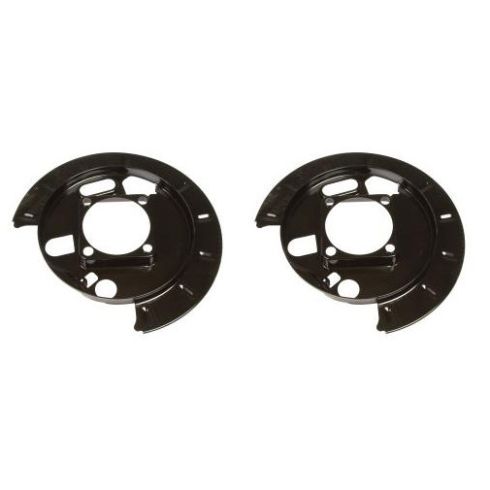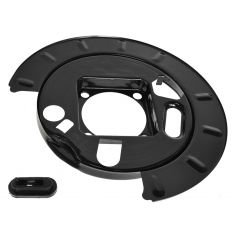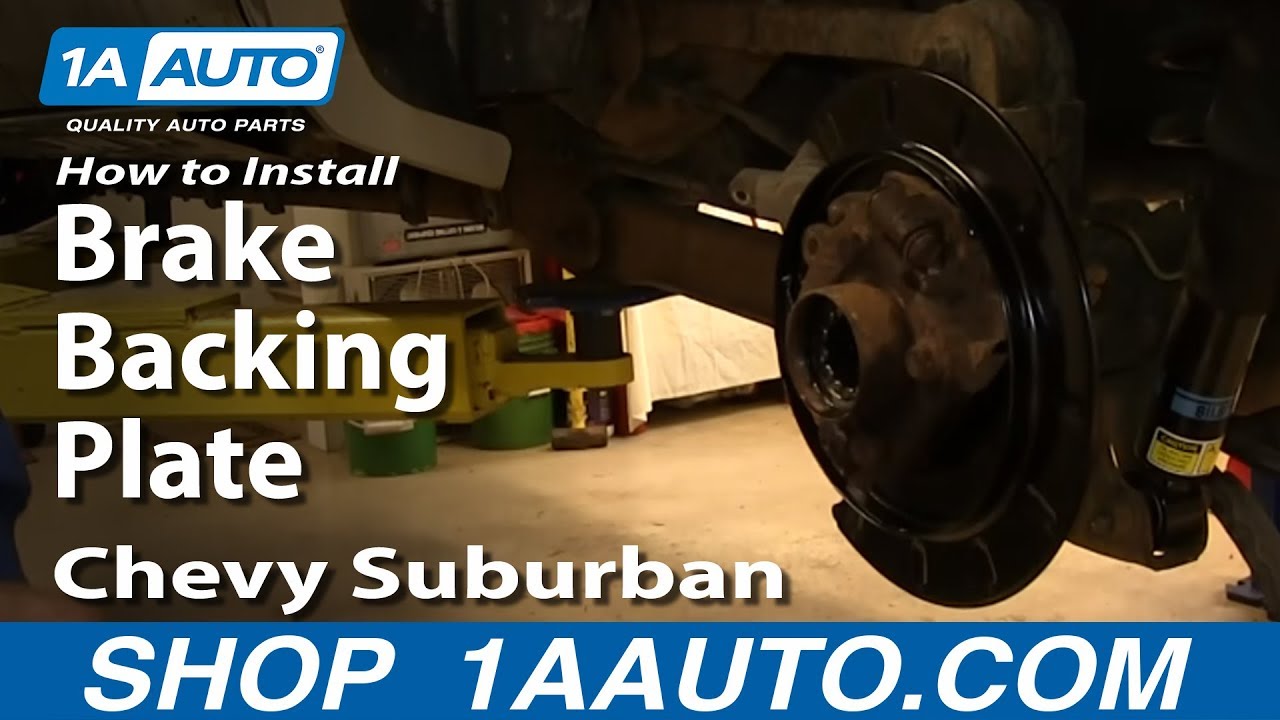Brought to you by 1AAuto.com, your source for quality replacement parts and the best service on the Internet.
Hi, I'm Mike from 1A Auto. I hope this how-to video helps you out, and next time you need parts for your vehicle, think of 1AAuto.com. Thanks.
In this video, we're going to show you how to replace a full solid rear backing plate on this 2002 Chevy Suburban, and it's pretty much the same for the Suburbans from 2002 to 2006, as well as the Tahoes and Yukons. The procedure is the same from left to right, in fact you'll see that we do some procedures on one side and other procedures on the other side. The items you'll need for this include a new rear backing plate from 1A Auto and this assortment of tools.
Start off by loosening up these lug nut covers. We'll fast forward as Don does this. Once those are all loosened up, you can pull the hub cap free. Now, you want to loosen the lug nuts preliminarily, raise the vehicle and remove them the rest of the way, unless you have air powered tools. Now, remove these two 12mm bolts, and we'll fast forward as Don does that. To loosen up your rotor either use a C-clamp to squeeze it or a screwdriver through the middle of it and pry between the caliper and the brake disc that loosens up the caliper so it comes off easier. Now, pry out the brake pads. Now, remove these two 18mm bolts using a piece of pipe to help break it free. We'll just fast forward as Don removes those two bolts. Now, pull your caliper bracket off, and pull the rotor off.
On the differential cover, there are either 10 to 12 bolts, and ours are pretty rusty so we use a cold chisel to knock the rust off of each side. These should be 13mm bolts if they're in good shape. We actually end up using a half inch socket because the rust has reduced their size just a little bit. You'll see later, we pound a half inch socket on there and are able to get them all off. We'll just fast forward here as Mike removes that bolt the rest of the way. Then he's just going to repeat the procedure on each of those other bolts all the way around the differential cover. For the higher ones, it does get a little more difficult and you will need an extension for your socket and ratchet to actually remove those bolts. Make sure you have a drip pan below the differential cover before you remove the last of the bottom bolts. You just want to remove those. Now, using your chisel, just hammer out on the bottom of the differential cover. Then replace the bolt at the top of the differential cover. Then use your chisel and hammer again on the other side and just let the fluid drain out. After it's drained for awhile, just pry out on the bottom and then remove that bolt and pull the cover down and out.
Now, if any debris falls down inside of here, as you can see right there, you just want to vacuum all of it out. Then take a rag, make sure it's somewhat clean, and just wipe everything down and stick the rag back in there. Then, using a razor blade, just cut off that old gasket along the outside. Use a wire brush to get any leftover residue of the gasket
For the next step, you'll probably want to put the vehicle in neutral. Rotate the drive shaft until you can see this 8mm bolt, put the vehicle back in park, and then you use an 8mm wrench to remove that bolt. Then remove the bolt, and then there is a pin that runs through the middle of the rear end there. Push it in a little bit just to get it going, and then push it out from the other side, remove it, that pin allows the axles to go in so push the axles in. Then you'll rotate your rear gear set again so you can see into the rear end and you see here there's a clip on the end of the rear end, you push the axle in and then you use a stick magnet to get that C-clip out. Then once that C-clip's removed, you can pull your axle right out.
There are clips that hold the emergency brake into the bracket. Using screwdrivers push one up onto the clip and push one down on the clip, and then release those clips. Then you can pull it out and slide it to the side. Then disconnect it. Then you just want to pry up on your brake shoes. Then pry out and then just pull them free. Then just remove these four bolts. We'll just fast forward as Mike does this. Now you can pull the old backing plate away. You just want to wipe down the area here with a wire brush to clean it up. As you can tell, on the left is the new backing plate from 1A Auto and on the right is what remains of the original backing plate. No mystery as to why we're replacing them. Actually, I realized right after I forgot to do it here, that there's a rubber boot that you put on around the arm, and then install your emergency brake actuator into the backing plate, then onto the axle, and then replace and tighten up those four bolts. Now, torque these 90 foot-pounds.
To reconnect the emergency brake cable, first connect it into the lever on the emergency brake actuator, and then you want to separate or pull the spring back until you can see a little bit of the cable. Run the cable through the bracket, and then once you get the cable through the bracket force the housing of the cable into the bracket. Then, reinstall your shoes just by spreading them apart a little bit. Getting them onto the backing plate, hook them into the hook that's at the top or the bottom and then get them on their actuators.
Reinstall your axle and you want to be careful not to damage the seal so lift up as you're sliding the axle in so that you don't damage the axle seal, and then once you get it most of the way in, you'll feel it hit the inner workings of the axle. You just got to move it up and down and twist it at the same time to get it in. Once it goes in, it goes in fairly easily. Make sure the axle is pushed all the way in, and then reinstall the C-clip on the end of the axle. Then, with the vehicle in neutral, you'll want to turn the gear set so that you can get the pin back in. Pull the axle out, make sure that everything is lined up through that hole, and reinstall the retaining pin for the axles. The hole needs to be on the bottom obviously. Then once you have that in then put that 8mm bolt back in and tighten it up.
Here you can see we're using a new differential cover. This differential cover came with a gasket, so I'm just putting a very light bead of RTV on it. Obviously, if you're using your old cover, just follow the directions on the RTV or whatever gasket you might use. Put it up into place, put the top bolt through and start the top bolt in. We'll fast forward here as we just start the rest of the bolts in. Make sure you put your brake line clip in place, and what we do is we just firmly tighten each of the bolts, let the RTV set up, and then torque the bolts to 15 foot-pounds. Now, remove this filler plug, using your 3/8 ratchet and ours is in rough condition so we're just going to hammer the ratchet in place. Then just remove that plug. Now, replace the differential fluid and you just want to do this until it starts to pour over the side. Once it starts to pour over the side, you can just put your pinky in there, make sure that the fluid's right to the top of filler hole, and if it is, then you're all set and you can replace your cap. Just tighten it up with your ratchet and you're all set.
If you're reusing your old router, you want to make sure that you scrap any rust scale from the inner edge of the braking surface, as well as from the edge of the emergency brake surface. If you don't do this, it's a good bet that some of this scale will hit against the new backing plate and make a squeaking noise. Usually the squeaking noise will go away over time, even if you get a little squeaking from the new backing plates. You can see here, we're using new routers, also available at 1AAuto.com. Install the router, and we put a lug nut on there just to hold it in place while we put the rest of the brakes together. Then put your caliper bracket back into place and replace those two 18mm bolts. We'll fast forward as Don tightens those up. You want to torque these to about 85 foot-pounds. Push your brake pads back into place. Then put your caliper back down into place and replace those two 12mm bolts. We'll just fast forward as Don does this and tightens them up. You want to tighten these to about 30 foot-pounds.
Put your wheel back in place. Then replace your lug nuts and tighten them preliminarily. We'll fast forward as Don does this. Now, you want to torque each of the lug nuts to 120 foot-pounds, and it is going to take awhile. Then reduce them to 100 foot-pounds. Then replace that hub cap and tighten up each of your lug nut covers. Before taking the vehicle out on the road, you just want to pump the brake pedal until it firms up, and then do a stopping test from five miles per hour and then ten miles per hour, and you're all set.
We hope this video helps you out. Brought to you by www.1AAuto.com, your source for quality replacement parts and the best service on the Internet. Please feel free to call us toll-free, 888-844-3393. We're the company that's here for you on the Internet and in person.











